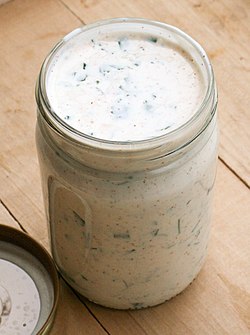Development
The original Ranch salad dressing recipe was concocted in the early 1950s by Steven Henson (1918–2007), a Thayer, Nebraska, native working as a plumbing contractor in the Anchorage, Alaska, area, while cooking to feed his work crews. Henson retired from plumbing at age 35 and moved with his wife Gayle to Santa Barbara County, California, where in 1956 he purchased a guest ranch in San Marcos Pass and renamed it Hidden Valley Ranch. [5] [6] [7] [8]
Henson served the salad dressing he had created at his Hidden Valley Ranch steakhouse, which became popular, and guests bought jars to take home. [6] The first commercial customer for ranch dressing was Henson's friend, Audrey Ovington, who was the owner of Cold Spring Tavern. [7] By 1957, Henson began selling packages of dressing mix in stores. [7] [8]
Henson began selling the dry ingredients in packages by mail for 75 cents a piece, and eventually devoted every room in his house to the operation. [7] By the mid-1960s, the guest ranch had closed, but Henson's "ranch dressing" mail-order business was thriving. [7] [8]
The Hensons incorporated Hidden Valley Ranch Food Products, Inc., and opened a factory to manufacture ranch dressing in larger volumes, which they first distributed to supermarkets in the Southwest, and eventually nationwide. [9]
Commercialization
Manufacturing of the mix was later moved to San Jose, then to Colorado, and then to Sparks, Nevada, in 1972. [7] [9]
In October 1972, the Hidden Valley Ranch brand was bought by Clorox for $8 million, [2] [7] and Henson retired. [7]
Kraft Foods and General Foods introduced similar dry seasoning packets labeled as "ranch style". Clorox reformulated the Hidden Valley Ranch dressing several times to make it more convenient for consumers, including adding buttermilk flavoring to the seasoning, allowing the dressing to be made using much less expensive regular milk. [2] In 1983, Clorox developed a non-refrigerated bottled formulation.
During the 1980s, ranch became a common snack food flavor, starting with Cool Ranch Doritos in 1987. Hidden Valley Ranch Wavy Lay's potato chips were introduced in 1994. [2]
In 1992, ranch surpassed Italian dressing to become the best-selling salad dressing in the United States. [2]
During the 1990s, Hidden Valley had three child-oriented variations of ranch dressing: pizza, nacho cheese, and taco flavors. [10] [11]
In 1994, Domino’s first started offering ranch sauce as a condiment with its chicken wings and pizzas, a combination that quickly became popular with customers. [12]
As of 2002, Clorox subsidiary Hidden Valley Manufacturing Company was producing ranch packets and bottled dressings at two large factories, in Reno, Nevada, and Wheeling, Illinois. [9]
In 2017, Hidden Valley Ranch Products turned over $450 million. [3]

